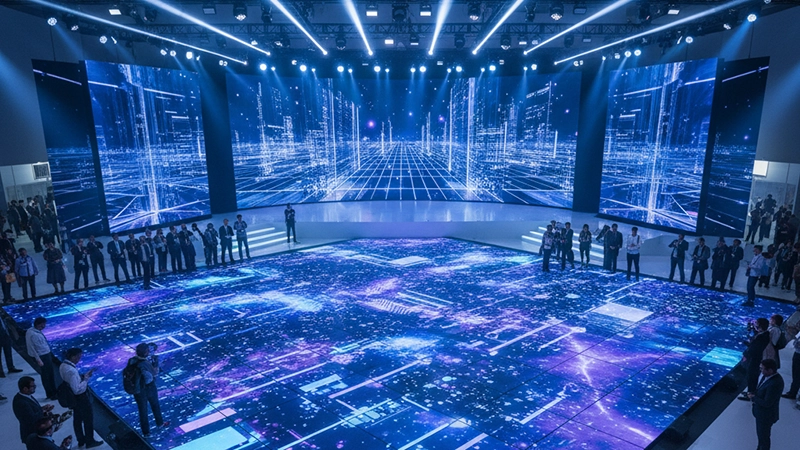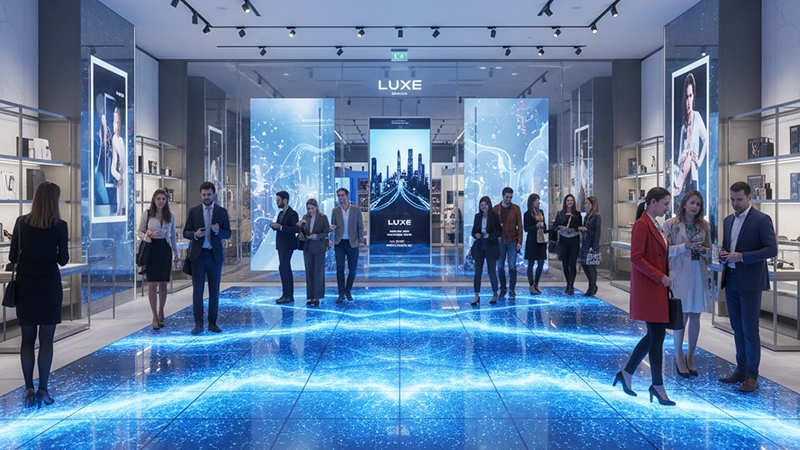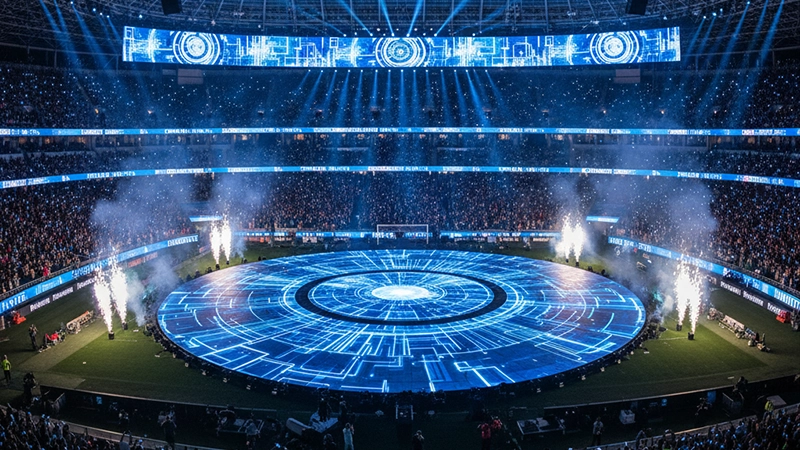An LED screen floor is a specialized type of digital display system that integrates LED technology into strong, load-bearing flooring panels. Unlike conventional LED walls or signage, these floors are designed for people to walk on, interact with, and experience visuals from above. They transform empty surfaces into immersive canvases that engage customers and enhance storytelling.
At trade shows and in retail environments, LED screen floors provide an innovative way to capture attention, highlight products, and differentiate from competitors. With variations such as LED panel floors, LED rolling floors, and interactive LED floor screens, businesses can adapt the technology to their specific event or venue needs. For buyers, choosing the right configuration involves balancing design requirements, technical specifications, and budget considerations.
An LED screen floor consists of modular LED panels housed in protective cabinets that can withstand constant foot traffic, heavy equipment, and dynamic stage environments. Each panel typically measures 500×500 mm or 1000×500 mm, and panels lock together seamlessly to form large surfaces.
Unlike standard displays such as indoor LED walls, the floor version is built with anti-slip tempered glass, reinforced aluminum frames, and shock-resistant components. This ensures safety for both performers and customers while delivering high-quality visuals.
The engineering of a floor LED display focuses on durability and clarity. Panels feature pixel pitches ranging from P2.5 to P6.25, balancing resolution with strength. Surface coatings protect against scratches, while load capacities of up to 2000 kg/m² make them suitable for concerts, exhibitions, and retail stores.
A led rolling floor refers to flexible or modular flooring panels that can be assembled and disassembled quickly. These are often used in trade shows where mobility and setup speed are critical. Their portability makes them attractive to rental companies and exhibitors who need a reliable but temporary display solution.
Trade shows are high-traffic environments where exhibitors must attract and retain attention quickly. A conventional booth may rely on banners or posters, but an LED screen floor introduces an entirely new dimension of engagement.
A led rolling display can transform an exhibition booth into a living showcase. For example, a car manufacturer might use rolling LED floor panels beneath a vehicle, synchronizing visuals with the surrounding LED video walls. The moving images highlight product features and draw crowds into the booth.
For smaller booths or mobile activations, a roll up LED display offers additional flexibility. These systems can be rolled, transported, and deployed quickly, providing exhibitors with a cost-effective way to deliver LED content without heavy equipment. When combined with LED floor panels, they create a full 360-degree experience for visitors.
One of the strongest advantages of LED floors is interactivity. An interactive LED floor screen allows visitors to trigger effects by stepping or moving across the display. At trade shows, this could be walking across a floor that responds with ripples, footprints, or branded animations. Such experiences create emotional connections and encourage social media sharing.
Retailers constantly seek innovative ways to enhance customer journeys. A static shelf or banner is no longer enough to differentiate in competitive environments. LED screen floors provide a multi-sensory experience that transforms shopping into an interactive activity.
In retail stores, an led panel floor can be used to guide customers through a showroom. For instance, illuminated floor panels can highlight new arrivals or direct traffic toward promotional zones. By embedding visuals underfoot, brands create a more immersive journey that increases dwell time.
A dynamic LED screen floor can display rotating promotions, product features, or interactive games. This adds a layer of excitement, making customers more likely to engage with products and spend more time in the store.
Interactive LED flooring brings entertainment into retail environments. Children’s stores may display animated characters that move when stepped on, while luxury retailers may use digital water ripples to emphasize elegance. These features not only attract attention but also enhance brand positioning.
When integrated with transparent LED displays, LED floors create multi-layered visual storytelling. A storefront might feature a transparent wall displaying branding while the floor beneath shows animated trails leading into the store. This combination maximizes visibility both inside and outside the retail environment.
Investing in an LED screen floor requires careful evaluation of technical specifications, safety standards, and operational flexibility.
Pixel pitch: Choose P2.5–P3.9 for close-up exhibitions, and P4.8–P6.25 for larger venues.
Brightness: Retail floors often require 900–1800 cd/m², while trade shows may need higher levels depending on lighting.
Refresh rate: For video playback and synchronized effects, aim for 1920 Hz or above.
Load capacity: Ensure the floor supports at least 1000–2000 kg/m² for safety.
In high-traffic venues, safety is non-negotiable. LED rolling floors must include anti-slip coatings, fire-retardant materials, and compliance with CE/RoHS certifications. Adjustable feet also ensure stability on uneven surfaces.
Many suppliers offer OEM/ODM services, allowing custom panel shapes, branded animations, and tailored software. This customization is critical for both trade shows and retail, where differentiation drives success.
Trade shows: Portability, quick setup, and rugged durability matter most.
Retail displays: Fine pixel pitch, aesthetic design, and seamless integration with existing store interiors take priority.
Suppliers play a critical role in ensuring performance and reliability.
Exhibitors often rely on rental LED screen floors for short-term events. These are designed for quick assembly and disassembly. Retailers, on the other hand, invest in permanent LED panel floor solutions for long-term value. Choosing between the two depends on budget and project duration.
Large venues such as stadiums integrate LED floor screens as part of a stadium display solution. These installations synchronize with perimeter LED displays, scoreboards, and entry-way LED systems. Retailers can adopt similar strategies, combining floors with walls and roll up LED displays to create multi-platform storytelling environments.
Certifications: Ensure CE, RoHS, EMC compliance.
Technical Support: Reliable suppliers provide training and after-sales service.
Customization: OEM/ODM flexibility is essential.
Global Experience: Vendors with international projects demonstrate proven capability.
Choosing the right LED screen floor requires balancing technical requirements with creative goals. Whether it’s an interactive LED floor screen for a trade show booth, an LED panel floor for a retail store, or a roll up LED display to complement mobile events, the right solution can significantly elevate customer engagement and brand visibility.
For buyers, focusing on specifications, safety, and supplier reputation ensures both long-term value and memorable experiences. As demand grows, the led screen floor is no longer just a novelty—it is a strategic investment for businesses seeking innovation in trade shows and retail displays.
Hot Recommendations
Hot Products
Get a Free Quote Instantly!
Talk to Our Sales Team Now.
If you are interested in our products, please contact us promptly
Reach out to our sales team to explore customized solutions that perfectly meet your business needs and address any questions you may have.
Email Address:info@reissopto.comFactory Address:Building 6, Huike Flat Panel Display Industrial Park, No. 1, Gongye 2nd Road, Shiyan Shilong Community, Bao'an District, Shenzhen city , China
whatsapp:+8615217757270